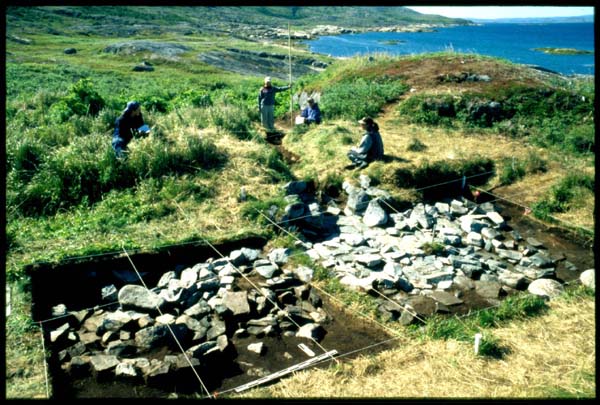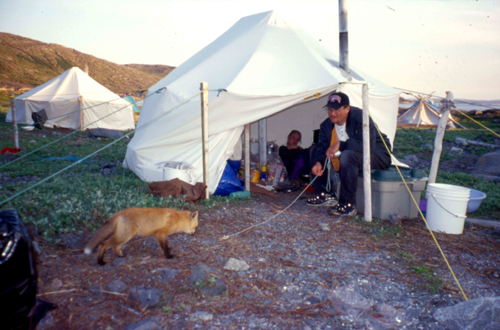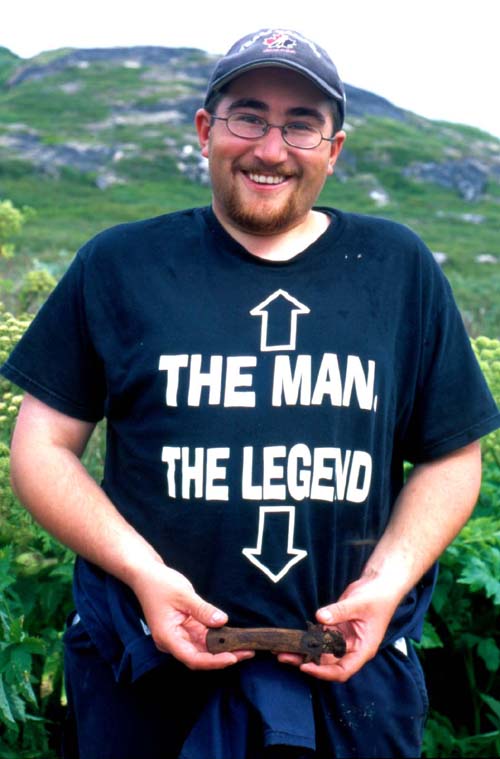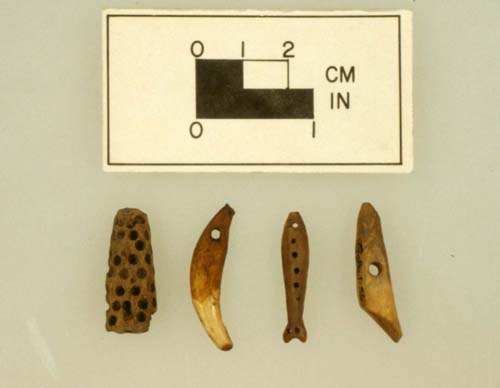
This View is of House-1 at Adlavik near the close of the 2002 summer excavations. The view is from the back of the house looking out over the entranceway tunnel that leads out to the midden. Lena Onalik is holding the measuring pole at the mouth of the entrance tunnel through which people would have crawled to enter into the house. Behind her is the House-1 midden. The rocks inside the house form a carefully prepared stone-slab floor as well as raised sleeping platforms and cooking stands for holding soapstone lamps.

Photo labeled "fishing for fox" is from the summer of 2000 when we had a pair of red foxes as neighbors at our camp. By the end of the summer they grew so tame that we used to toss them scraps. Here Bernie Anderson has tied a duck bone to a string with which he is playing tug-of-war with the fox who we called "Gunther". During the day Gunther and his sister would sometimes come by the site and watch us dig.

Adlavik Harbour House-4, 2003 excavations. In the photograph you see the extent of the 2003 excavations which have opened-up the central portion of the house. The photograph is taken from the vantage point of the entrance tunnel coming into the house. The sleeping platform itself was not excavated, it is where Erin, Jillian and Julia are sitting. The actual interior of House-4 is more-or-less delineated by the trampled brown grass, you can see that we excavated about half of the house. The fact that much of the side walls and the front walls, which would originally have been of sods, was missing leads us to suspect that House-4 and House-2 behind it were the first two structures built at Adlavik. When these houses were abandoned , or in need of repair, they were taken down and their timbers and sod used to construct the far more visible and substantial appearing structures House-1 (which we excavated) and House-3. None of the work at Adlavik would have been possible without the excellent help of our team including the three young women shown here: Erin Andersen, Jillian Mitchell and Julia Ford.

This is a photograph of Bernie Andersen holding the fabulous whale-bone knife handle he excavated in House-1 in 2002. It still retains a little bit of the iron blade it once had that was rivetted to the handle.

This slide shows the four miniature carvings that we have excavated at Adlavik and which are among our most interesting artifacts recovered to date. From left to right there is a perforated rectangular piece of whalebone (although covered with small drilled holes, none of them go all the way through), a perforated seal's tooth, a miniature carved effigy of a whale, jumper or porpoise, and a miniature ivory harpoon head. Were these toys? charms? jewelry? we don't know....

Perhaps the most special find of the 2003 field-season was a beautiful miniature harpoon head carved out of walrus ivory with a small iron end-blade. It was found in House-4. Again one has to wonder if this was a toy for a young Inuit boy to practice his hunting prowess? Was it a charm to assure good hunting? Or was it a small specialized dart used to attach a line to a seal in the water?

Here are some of the variety of small glass and bone beads found in the old Inuit houses at Adlavik.